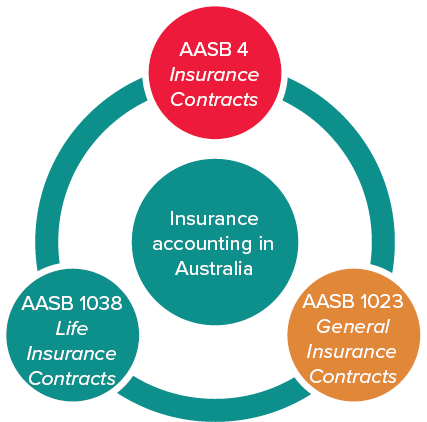The implications of IFRS 17 Insurance Contracts for non-insurers
For many non-insurers, the question of whether their transactions with customers and suppliers are, or incorporate, insurance contracts has seldom been a priority. Insurance contracts are typically regarded as specialised contracts issued only by registered insurers. Non-insurers, however, can and do issue contracts that provide insurance coverage to other parties.
Background to the development of IFRS 17
To date, typically only those Australian reporting entities specifically involved in issuing insurance contracts or contracts with explicit insurance components have concerned themselves with the accounting for insurance contracts. In contrast to other jurisdictions that have adopted International Financial Reporting Standards (IFRS), Australia largely retained its local pre-IFRS accounting requirements for life and general insurance contracts, and adopted IFRS 4 Insurance Contracts to be applied to those insurance contracts that didn’t otherwise fall within either the life or general insurance categories (AASB 1038 Life Insurance Contracts and AASB 1023 General Insurance Contracts). Consequently, the application of AASB 4 Insurance Contracts (the Australian equivalent to IFRS 4) has generally been limited to accounting for roadside assistance products.
While Australia had in place reporting requirements for insurance contracts prior to the adoption of IFRS, many other jurisdictions had few, if any, corresponding requirements. Faced with this significant and worldwide diversity in accounting practice, the International Accounting Standards Board (IASB) decided a ‘staged’ approach was the most appropriate. To this end, IFRS 4 attempts to strike a balance between setting a minimum standard of reporting in respect to insurance contracts, and accommodating the diversity in insurance accounting practices by:
- Permitting those entities that had previously asserted explicitly that they regarded financial guarantee contracts as insurance contracts to irrevocably elect to apply eitherof the following to such guarantee contracts:
- IAS 32 Financial Instruments: Presentation, IFRS 7: Financial Instruments: Disclosures and IAS 39 Financial Instruments: Recognition and Measurement, or
- IFRS 4,
- Not specifying a comprehensive insurance liability measurement model but requiring insurers to apply, at a minimum, a liability adequacy test to recognised insurance liabilities as a means of determining whether their provisioning, based on current estimates of future cash flows, is adequate. If an insurer’s provisioning is determined to be inadequate, the entity is required to remeasure the liability and immediately recognise the remeasurement as an expense in profit or loss, and
- Exempting insurers from applying the criteria in paragraphs 10-12 of IAS 8 Accounting Policies, Changes in Accounting Estimates and Errorsto its accounting policies for:
- Insurance contracts that an insurer issues (including related acquisition costs and intangible assets), and
- Reinsurance contracts that the insurer holds.
In the Basis for Conclusions to IAS 39, the IASB notes that:
‘Mindful of the need to develop a ‘stable platform’ of Standards for 2005, the Board finalised IFRS 4 in early 2004 without specifying the accounting for these (financial guarantee) contracts and then published an Exposure Draft Financial Guarantee Contracts and Credit Insurance in July 2004…’
The IASB’s July 2004 Exposure Draft attracted mixed views. Some respondents suggested there are important economic differences between credit insurance contracts and other contracts that fall into the financial guarantee category. Some respondents, however, argued that some financial guarantee contracts contain features similar to those found in insurance contracts, including cancellation and renewal rights and profit-sharing features.
In order to establish a stable suite of International Accounting Standards by 2005, the IASB took the pragmatic decision to provide an irrevocable accounting policy option to insurers that permitted them to reclassify any financial guarantee contracts they had previously asserted to be insurance contracts as financial instruments.
The advent of IFRS 17
Always anticipating at least a second phase of the project, IFRS 4 was never intended to be a permanent feature of IFRS. Accordingly, in July 2004 the IASB commenced what it described as ‘Phase II’ of its project on insurance contracts, culminating in the publication of IFRS 17 Insurance Contracts in May 2017. IFRS 17 was originally intended to be effective from 1 January 2021. However, in light of feedback from constituents, the IASB has now deferred the starting date of IFRS 17 to reporting periods beginning on or after 1 January 2023.
Consistent with its policy of aligning Australian Accounting Standards with IFRS, the Australian Accounting Standards Board (AASB) has published IFRS 17 as AASB 17 Insurance Contracts, and aligned its commencement date with that of IFRS 17.

When effective, AASB 17 will replace all current Australian Accounting Standards dealing with insurance contracts, including AASB 4, AASB 1023 and AASB 1038. However, AASB 17 does not apply to public sector entities. Instead, these entities will continue (for the time being) to apply AASB 4, AASB 1023 and AASB 1038.
IFRS 17 substantially retains the scope of IFRS 4. Accordingly, most contracts that previously fell within the scope of IFRS 4 will fall within the scope of IFRS 17. As compared to its predecessor, however, IFRS 17 requires insurers to, among other things:
- Measure the insurance contracts they issue at current value using updated assumptions about cash flows, discount rates and risks at each reporting date
- Report estimated future payments to settle incurred claims on a discounted basis, and
- Use a discount rate that reflects the characteristics of the insurance cash flows to measure their insurance contracts.
As noted above, over the next few months we will be looking in detail at the features of an insurance contract within the scope of IFRS 17 and the accounting for insurance contracts under IFRS 17, with a particular emphasis on the potential reporting implications for non-insurers.